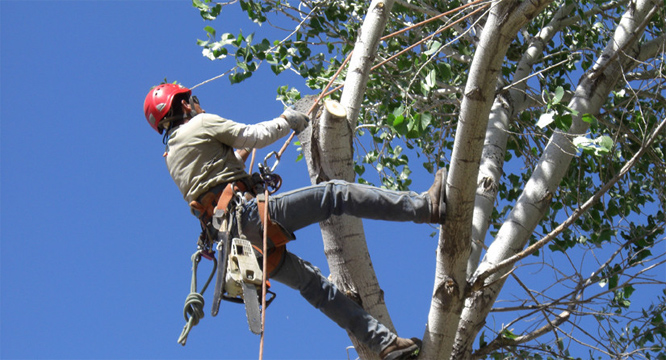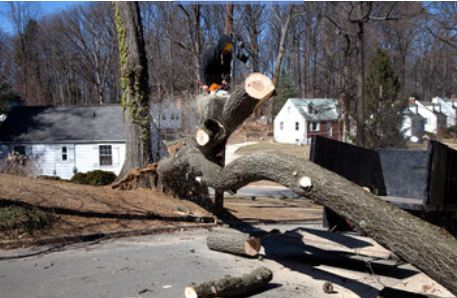Tree care is the practice of maintaining and improving the appearance and health of trees and shrubs. It is best to focus on proactive care, as an ounce of prevention is worth a pound of cure.
Watering is essential for preserving tree health. Newly planted trees require about five gallons of supplemental water per inch of trunk diameter, measured six inches from the ground. Click here to Learn More.

Roots are the nutrient transfer system for your tree and are a vital part of its health. A healthy root system provides water, oxygen and minerals to the tree. They also anchor trees in the ground, support their structure and help protect against soil erosion.
The roots of a mature, established tree can extend to a radius of up to four times the width of the crown. Because of this, it is important that the area surrounding a tree is well-maintained to avoid damaging the root system or causing damage to pedestrians and property.
Many factors can negatively impact the root environment and lead to root diseases or structural failure of your trees. These include root girdling, a condition that occurs when roots wrap around or choke out the trunk of a tree. Girdling roots can restrict a tree’s ability to take up nutrients and moisture from the ground, leading to slow decline or even death of the entire tree.
Other problems with the root environment can be caused by soil compaction, changing in soil depth, over- or under-watering and improper fertilization. Overwatering causes soil pore spaces to fill with water, restricting the amount of oxygen available to roots. Overfertilization can lead to nutrient imbalances, injuring or killing roots. Competition between roots, grass and weeds can also stress trees.
If the root zone of your trees begins to encroach on costly systems such as sewer and plumbing, it may be necessary to install barriers to prevent damage or blockage. Your local, experienced tree service professionals can recommend the right solution for your situation, utilizing either mechanical or chemical barriers to keep the roots at bay.
Taking care of your trees through a regular root maintenance program is much more beneficial than pruning, spraying fungicides or almost any other form of tree services. Root maintenance is a relatively inexpensive way to ensure that your trees are healthy and thriving.
Pruning
When pruning is done properly, it can improve the appearance of the plant, reduce risk and encourage healthy growth. Proper pruning also promotes flowering and fruit production, helps to prevent disease and insect damage and keeps limbs from falling in the yard or near structures. It is important to understand that each type of plant has its own unique pruning needs, as they all grow differently and require different styles of pruning.
Removing dead, dying or damaged branches can help reduce the potential for storm damage. This includes removing crossing, rubbing or entangled limbs as well as those that are too close to other branches, power lines or buildings. It is also important to remove limbs that have been damaged by insects, freeze or thaw damage or old age. In some instances, it is necessary to prune out damaged root flares and collar areas of grafted plants. It is important to always make your pruning cuts with sharp, clean tools and to follow proper techniques. A flush cut, which is a straight down cut at the base of the branch or trunk, will open up wounds that will lead to decay. This can also result in the loss of a significant portion of the tree’s bark, leaving it exposed to the elements and potential entry points for forest pathogens.
Formative pruning is the structural shaping of young trees and shrubs to develop a strong framework for future growth. This is usually done at the nursery or during their first few years in the landscape and can minimize the time and labor required to care for them later. It is important to train young trees and shrubs to a desirable form early on so that they can adapt to the landscape without becoming overgrown or damaged by improper pruning practices.
Other pruning objectives may include reducing the overall density of the canopy, allowing more sunlight to reach the ground and encouraging healthy new growth. However, thinning should only be done on those varieties that respond well to this practice. Some oak species, for example, may be negatively affected by too much thinning as it can diminish the amount of stored carbohydrates and leave them more vulnerable to fungal diseases.
Removal
Trees in decline can become a serious health risk to the surrounding ecosystem, spreading pathogens and pests that threaten other trees in the area. If a diseased or infested tree cannot be saved with treatment, removal is often the best option. The team at Tree Time carefully assesses a tree’s condition through detailed inspections, and takes into account the needs of surrounding vegetation when making removal decisions.
Among the most obvious reasons for tree removal is the potential threat it poses to structures like homes, driveways, and power lines. Severely weakened or diseased trees may become unstable and fall, potentially causing significant damage. In such cases, it is critical that a professional plan be put in place to remove the tree without damaging any surrounding property.
In addition to safety concerns, a number of other circumstances can warrant the removal of a tree. Overgrowth can obstruct views or impede walkways, and large root systems can cause damage to foundations or sewer pipes. Additionally, some species of trees can be invasive and interfere with the ecology of a residential landscape. In such cases, removing the problematic tree can improve aesthetics and promote a healthy ecosystem on a residential property.
Once the decision to remove a tree is made, the team at Tree Time meticulously plans and prepares for the operation. This includes securing the necessary permit, setting up safety barriers, and notifying neighbors if necessary. Our crews also evaluate the safest method for removing the tree, taking into consideration factors like the size of the trunk and its location on the property.
The actual process of removing a tree can be incredibly dangerous, especially when done incorrectly. To ensure the safety of everyone involved, our team uses proper personal protective equipment (PPE) when working on a site. This includes heavy gloves, boots, hard hats, and ear protection. We also use specialized machinery for cutting down and disposing of the tree, including cranes and stump grinders, when needed. When a tree is removed, we take care to make sure all debris is cleared away and completely gone.
Emergency Services
Unforeseen weather, pest infestations, structural damage and more can wreak havoc on a tree’s internal and external structures. Some problems may be too severe to be fixed through routine maintenance and will require immediate attention. This type of emergency support is what tree care professionals provide and why it’s important to select a company with a proven track record.
Fallen Trees
Branches and trees that have fallen due to severe weather or other causes can block roads, damage structures and pose a risk to people and vehicles. In addition, debris can be a fire hazard for homes and businesses. Emergency services include removing fallen branches, trees and stumps to prevent accidents and restore safety.
Downed trees can be particularly dangerous as there may be no warning before they break apart or fall. They can also block access to power lines and other utility services. Emergency services are essential to keep the public and property safe.
A quality local tree service will care about their customers and the community. They will have a good reputation, offer local references and be able to explain their work in an understandable way. If you are looking for a tree service, ask for proof of insurance and make sure they have an ISA certified arborist on staff.
Monitoring – Keeping tabs on the health of trees, including their root systems and bark, is critical to early detection of problems. This enables the quick response to reduce or eliminate issues such as fungal infections, insect infestations and disease.
Watering – Newly planted trees and those in urban environments need regular, deep watering to promote healthy growth and help them adapt to drought conditions. Trees are also impacted by dry soil, which limits their uptake of nutrients and moisture.
Mulching – Newly planted and existing trees benefit from mulch, which conserves water, moderates soil temperatures and improves the structure of the root system. It also helps protect trees from damage caused by foot traffic, lawn mowers, de-icing salts and other contaminants.
It is possible to avoid most problems by implementing a good tree care regimen. Proper planting, species selection for the location and proper installation are vital to long-term health. Incorporating regular pruning, inspections and other maintenance practices can also help ensure that your trees and shrubs stay happy and healthy.

